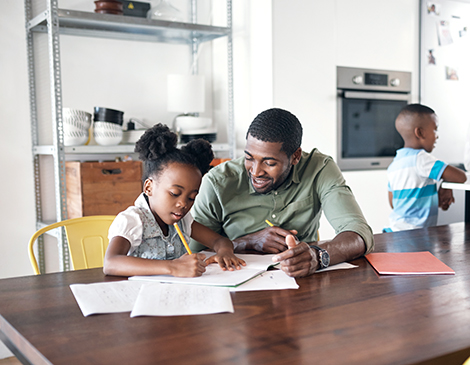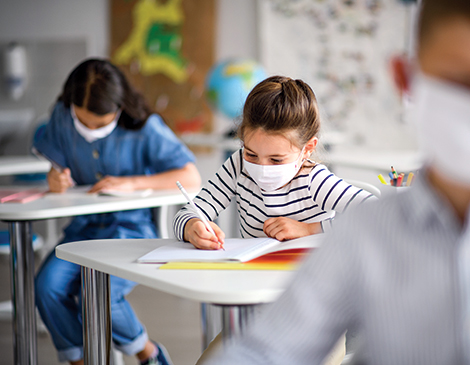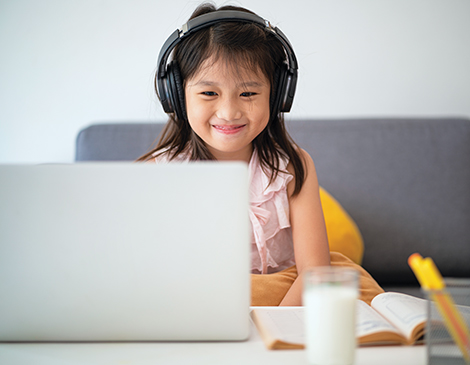Masks, face shields, hand sanitizer — back-to-school supplies this year look different for families preparing for the new normal, which for some meant Zoom classes from home, and for others was a cautious return to the building.
Many parents who were given a choice of online learning or in-class experiences grappled with the decision.
“There are so many unknowns that the school can’t necessarily control, and while I know it’s a safe place to go, I had a lot of anxiety about the spread of COVID-19 and protecting the grandparents,” says Sara Barresi, whose 11-year-old son, Sebastian, entered sixth grade in Lawrence School’s online program.
Meanwhile, small class sizes at Hawken School was an encouraging factor for Holly Wiertel, who has a high school senior and seventh grader. “We really want them to be back in the classroom to have the experiences and socialization that they get with their peers,” she says.
Even still, Wiertel says she struggles with the reality that her graduating senior will not have the traditional milestones that students anticipate such as homecoming weekend or checking out colleges in person.
“We are thankful that we were given the option to send them back,” she says. “And I respect both sides — some parents feel better about their kids staying home and doing remote learning.”
Ultimately, parents want choice.
“That is the word of the day — choice,” says Chaz Napoli, president at St. Martin de Porres High School in Cleveland. “And they want clarity. So, that is what we are trying to provide on our end, as are other schools.”
St. Martin de Porres, a private school that serves kids from families of limited economic means, follows the Cleveland Metropolitan School District schedule, which was to start the year with 100% remote learning. When making a decision to return later in the fall, the school will continue to survey stakeholders including faculty and staff, work-study program partners and parents.
Napoli says they’ll watch how schools that opened fare with safety measures.
“We’ll see how they do during the first six to seven weeks, and that will make us either more or less comfortable [with in-person learning],” he says. “But sooner or later, we are going to be back on campus with some risk, because there is never going to be a situation where there is zero risk.”
The thing is, what feels comfortable to some parents is simply not OK to others. And the 24/7 news reel of COVID-19 updates exacerbates back-to-school stress.
“One day, you watch the news and you feel great — and the next day, you watch and you feel terror and fear,” says Vanessa Diffenbacher, associate head of the lower school at Lawrence School.
Uncertainty is on the syllabus no matter what schools decided this fall.
“Everything in the age of COVID comes with an asterisk,” says Scott Looney, head of school at Hawken. “We have to be prepared to pivot in and out of remote learning.”

Online Learning Lessons
When Hawken surveyed its parents, 80% wanted their children back in the building, 10% preferred remote-only learning and 10% weren’t sure which option to choose.
“Us not being available to their kids was some of parents’ biggest concerns,” Looney says.
Schools also evaluated what did and didn’t work in spring when emergency online learning was instituted practically overnight. Looney says young kids had a tough time with it.
“Our 5-year-olds needed a parent to be a co-teacher at home, and not everyone can do that,” he says.
Bandwidth and internet access were issues, too. After schools went remote in March, student advisory group leaders, who each are responsible for seven to eight students at St. Martin de Porres, reached out to families.
“Within a day, we were able to reach all of our families and put together a list of anyone who was struggling with connectivity, and it was a reasonable list,” Napoli says.
The school purchased hot spots for families and ensured that students were supplied with Google Chromebooks.
Wiertel says her family updated their broadband several times to accommodate two work-from-home parents on Zoom and three children logged on for remote learning.
“We had to make sure we had enough bandwidth and download speed for all of us to Zoom at the same time,” she says. “We learned more about that then we ever wanted to think about!”
Diffenbacher says Lawrence School, which specializes in serving students with dyslexia, dysgraphia, dyscalculia and ADHD, is dedicating time to teaching younger students to navigate Google Classroom, which was tough for them in March. Though the hardest part about early efforts was the emotional aspect.
“A lot of kids were upset about not going to school,” she says. “So, our teachers needed to be vigilant about reading between the lines with kids to make sure everything was OK on the home front.”
Lawrence School offers clinical and school psychologists who can set up virtual appointments with families and students, respectivley.
“We are prepared to intervene if we need to,” Diffenbacher says.
Also, tutoring services through its Academic Center for Enrichment are held via video.
“Some of our families hands-down love it so much they don’t want to go back to face-to-face,” she says.
When building the curriculum for the fall, St. Martin de Porres opted to engage students with more live online learning instead of the mostly on-demand videos students accessed in March and April. The school now offers virtual office hours and support, and a new block schedule with three distinct breaks will give students time away from their screens. In all, it comes down to increasing accessibility.
“We tried to find a sweet spot between asynchronous and live streaming,” Napoli says. “We felt we could do better to make this feel like more of a school year, so our online plan for fall is much different [than spring].”

The New School
Messaging is key to helping parents understand what protocols schools will take to keep children safe, and Lawrence School is addressing this with a color-coded awareness system that is based on factors such as number of infections of school staff and students.
For example, green means there is flexibility to move in the hallway at a safe social distance to attend classes such as gym or music. Green also allows for some mask breaks for younger children, whose desks are all placed six feet apart. Yellow is masks all of the time and limited movement. (The school started its year on yellow.) Red is 100% online learning.
The color code will be shared with parents and staff and will be visible on the school’s website.
“We felt the messaging strategy was important to make sure that our entire community is on the same page,” Diffenbacher says. “So even if you don’t know all of the specifics, you understand when we are going to be really strict.”
Lawrence School gave parents a choice of in-person or online learning, and families can change their minds and move kids in and out of the classroom if they choose.

“We are not locking families into the decision for months,” Diffenbacher says.
About 20% of families opted for remote learning. Whether students are in-person or at home, they’ll keep the same teacher and synchronous lessons using a swivel webcam that follows the instructor around the classroom.
“[Online learners will feel as if] they’re sitting on the outside of the classroom looking through a window,” Diffenbacher says. “It’s so important to have consistency and to keep relationships between teachers and students strong.”
Hawken is also using the swivel web cams in its classrooms for conducting live-stream learning. All students are required to wear masks, and the school will frequently clean and sterilize all surfaces. A handbook of protocols was distributed to parents, which includes everything from how students will safely use restrooms to which building entrances and exits different grades will access.
“Even the little ones are pretty good at keeping masks on,” Looney says.
However, the youngest children in Hawken’s toddler programs will not be required to wear masks.
“They’re not quite old enough yet,” he says.
Teachers, however, will be fully protected with face masks and shields.
“If a 3-year-old needs a hug, they are getting a hug,” Looney says. “You don’t want to treat young children like they are toxic, so we are focused on the safety of adults for that age group.”
Preschool children are divided into cohorts of six to eight students and two teachers.
Hawken is providing laptops for students third grade and up. Some teachers will use Google Classroom to organize work and Zoom to facilitate lessons.
Also, the school assigned the role of “personal learning coach” to remote teachers who could not return to work in the building due to health reasons. So, if a student is stuck on a concept, the coach can provide one-on-one support a few times a week.
Lawrence School acknowledged that teachers need to manage their own children’s remote learning as well. So, the school dedicated a classroom with aides so teachers’ kids can come to school and participate in their districts’ programs.
“Our teachers are incredibly valuable, and it takes years of training to get them to where they are,” Diffenbacher says. “We want to help them, and it takes the pressure off of teachers with elementary-aged students.
On top of frequent handwashing, face coverings, desk-cleaning, social distancing and robust online programs, the 2020-2021 school year is simply going to be different. But there are some silver linings.
“Distance learning has just boomed,” Diffenbacher says. “This is definitely changing our mindset to reach more children with language-based learning differences to support them in a way that doesn’t require them to be right here in the Cleveland area.”
In fact, a family from California reached out to Lawrence School about its summer online program.
Across schools and districts, this summer was all about extensive professional development.
“We used our break to better enable our faculty and staff to handle online learning,” Napoli says.
And families are going into the year understanding that the only certainty is change. Many have built even stronger partnerships with schools and teachers to navigate the pandemic learning environment.
“I’m thankful that the leadership spent so much time working hard to make sure our kids are going back in the safest way possible,” Wiertel says.




